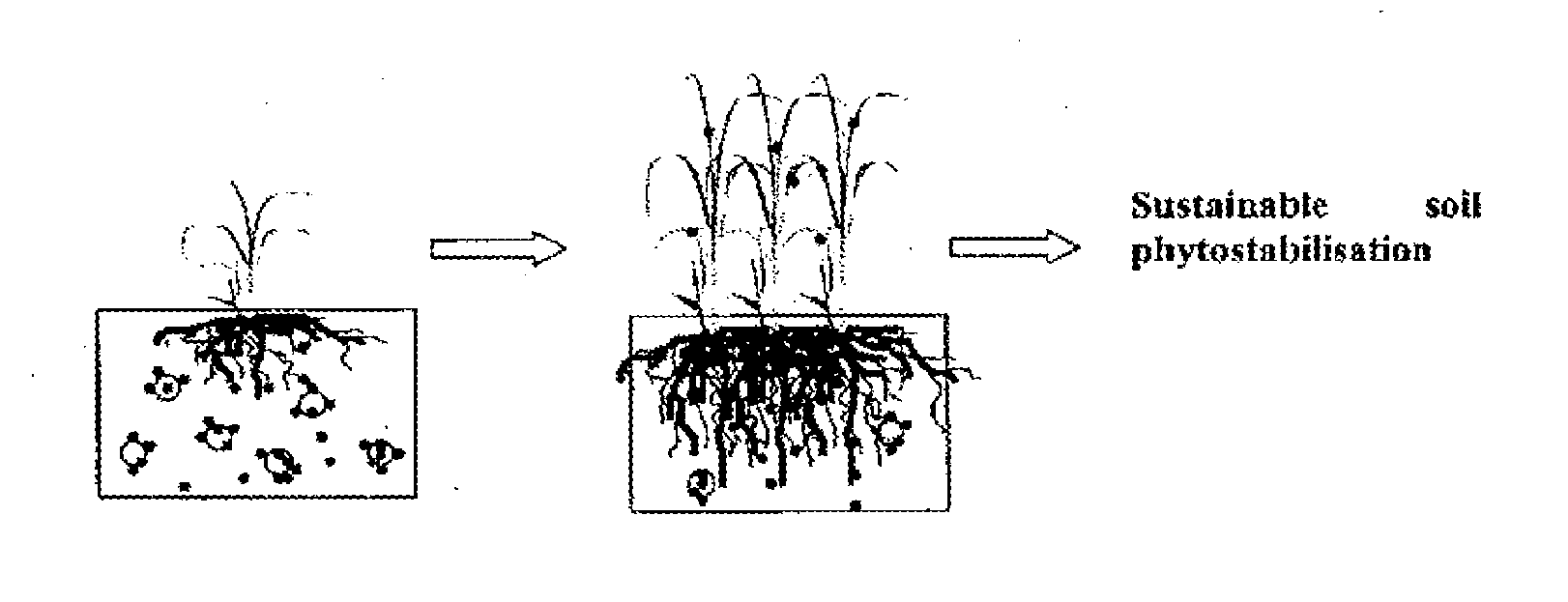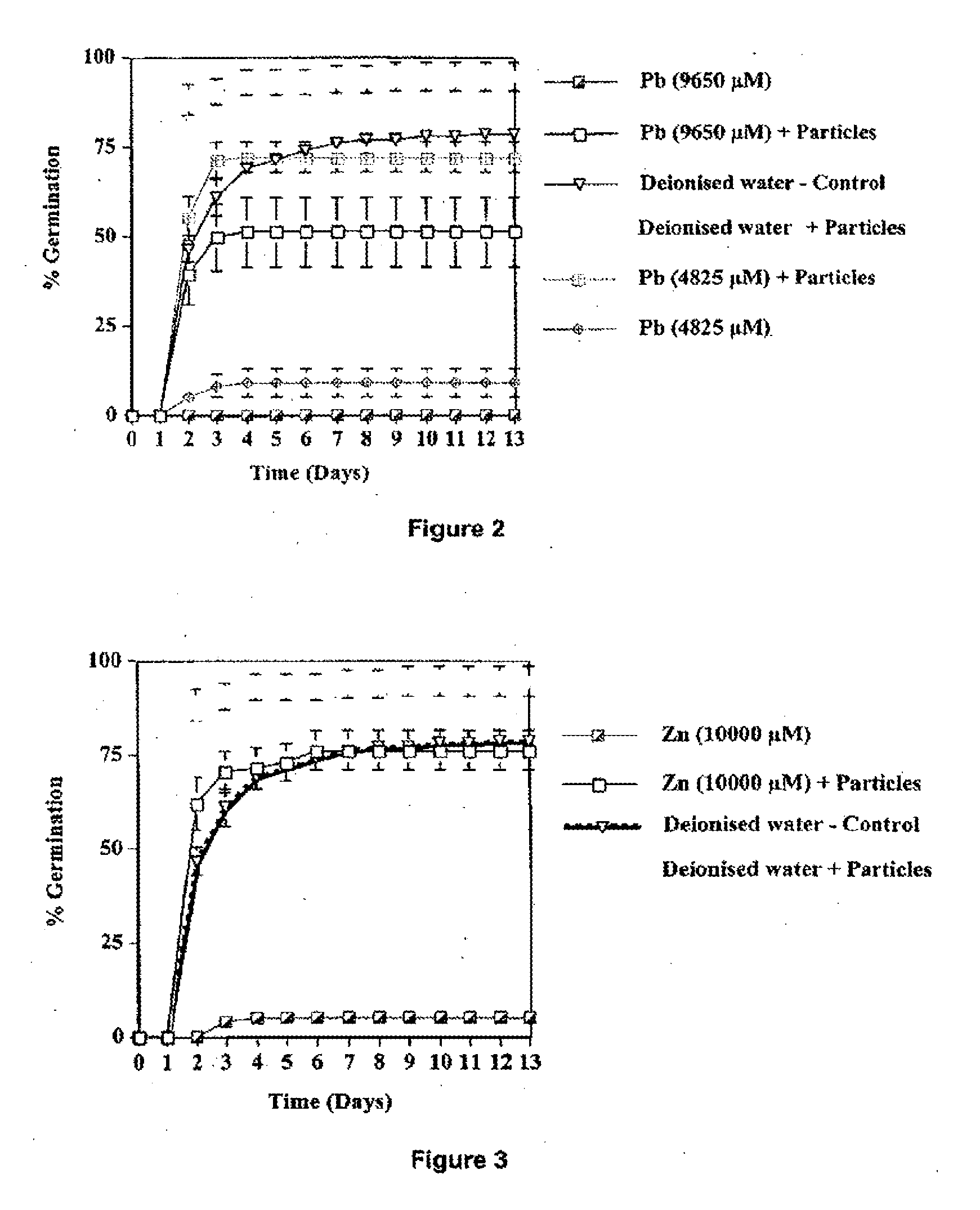Soil remediation process
a soil remediation and process technology, applied in the field of soil remediation, can solve the problems of high risk of contaminant dispersion into adjacent areas, uranium and metalloid arsenic, and elevated levels of metals within landscapes
- Summary
- Abstract
- Description
- Claims
- Application Information
AI Technical Summary
Benefits of technology
Problems solved by technology
Method used
Image
Examples
example 1
Synthesis of Metal Binding Hydrogel Micro- and Nanosized Particles
[0122]Designer particles suitable for both irreversible metal sequestering and storage of water to assist revegetation in drought conditions were synthesized from ‘living’ radical polymerization. Dimethyl acrylamide and bisacrylamide monomers were copolymerized via RAFT-mediated emulsion polymerization (Juranicova et al., 1998) to produce crosslinked hydrogel particles (NP1). A macromeric RAFT agent was used in the synthesis, namely P (DMA)-RAFT (5CNUR69, Mn=4000, PDI=1.11). The RAFT agent was hydrolysed to thiols (NP2), which are known to bind irreversibly, to a wide range of heavy metals (e.g. Hg, Cd, Cu, Pb). In cases, where selectivity is required, the dithioester (NP1) could also be utilized (Bell et al., 2006). These hydrogels (polyacrylamide) exhibit a high water retaining capacity (greater than 90% of its mass), good mechanical strength and their decomposition products have been shown to pose no environmental ...
example 2
Capacity of Particles to Sequester Heavy Metals in Solution
[0123]Experiments were conducted using four different types of particles, (i) control (polymer without xanthate), (ii) xanthate and (iii) thiol (after hydrolysis of xanthate) microsized particles, and (iv) macromeric RAFT agent P(DMA)-RAFT_trithiocarbamate nanosized particles. Particles were added to 10 mL of heavy metal solutions and mixed overnight. A ratio of 1 mole of RAFT to 2 moles of heavy metals was used. Four different metals / metalloid (arsenate, lead, copper and zinc) were selected for the study and only one concentration per metal (identified as toxic to the Australian native grass Astrebla lappacea during germination experiments) was tested (i.e. 667 μM As, 9650 μM Pb, 4000 μM Cu and 10000 μM Zn). After centrifugation of the mixing solutions, supernatants containing the fraction of free soluble metals that were not sequestered by the particles (metals bound to the particles were in the pellets) were collected and...
example 3
[0126]Assessing the Germination Potential of the Native Grass Astrebla lappacea Under Toxic Heavy Metal Conditions in the Presence of Thiol Particles
[0127]Seeds were germinated in a germination cabinet under control (sterile deionised water) and heavy metal conditions in the presence or absence of particles. Different concentrations of Zn (ZnCl2) and Pb (PbCl2) solutions were used, but for brevity, results using toxic concentrations of Zn (10000 μM) and Pb (9650 and 4825 μM) only (that were also chosen for the mixing experiments previously described) will be presented. Petri dishes and filter papers were used to conduct the germination trial (five replicates per treatment and 25 seeds per Petri dish). 10 mL of sterile deionised water or metal solution were added to each Petri dish. Particles (ratio 1 mole of xanthate to 2 moles of heavy metal) were added uniformly on the surface of the filter papers.
[0128]The Petri dishes were sealed with parafilm and placed in a transparent plastic...
PUM
| Property | Measurement | Unit |
|---|---|---|
| Temperature | aaaaa | aaaaa |
| Fraction | aaaaa | aaaaa |
| Fraction | aaaaa | aaaaa |
Abstract
Description
Claims
Application Information
 Login to View More
Login to View More - R&D
- Intellectual Property
- Life Sciences
- Materials
- Tech Scout
- Unparalleled Data Quality
- Higher Quality Content
- 60% Fewer Hallucinations
Browse by: Latest US Patents, China's latest patents, Technical Efficacy Thesaurus, Application Domain, Technology Topic, Popular Technical Reports.
© 2025 PatSnap. All rights reserved.Legal|Privacy policy|Modern Slavery Act Transparency Statement|Sitemap|About US| Contact US: help@patsnap.com



